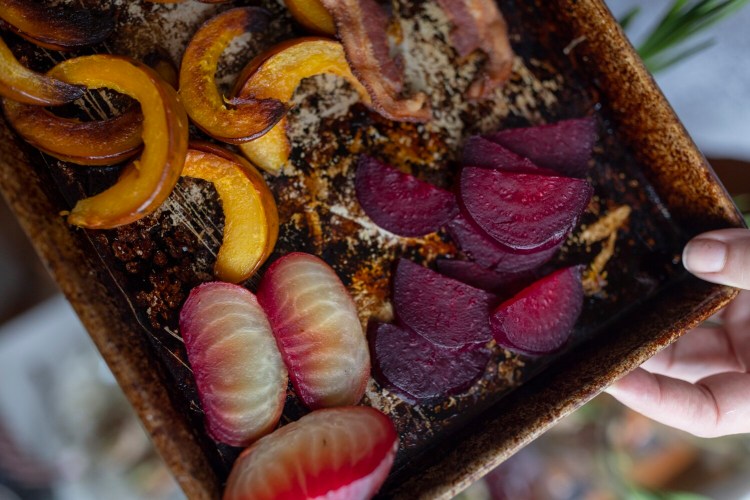“Many people eat salad dutifully because they feel it is good for them, but more enlightened types eat it happily because it is good,” wrote Laurie Colwin, who before her untimely death in 1992 at age 48 had written five novels, three collections of short stories and two volumes of essays and recipes. She was famous for her portrayal of New York City society in her novels and her food columns in Gourmet magazine.
The day after my beefy Christmas dinner, two days after the Feast of the Seven Fishes, three days after I made my 20-something kids decorate Christmas cookies with their Momma for old times’ sake, the day before my 54th birthday and only five days before I squeeze into that little black dress for New Year’s Eve, I’m reading a double meaning into Colwin’s choice of the word “enlightened.”
Blue cheese dressing aside (which can have as many calories ounce per ounce as hot fudge sauce), salad has long been how many eaters try to boost their dietary fiber while curtailing their calories to – literally – lighten up a bit. But to Colwin’s point, an open-minded salad composer can figuratively enlighten eaters on the prospect of salad being so much more than warm-weather ingredients trucked in from the West Coast. Even in midwinter in Maine.
Aquaponic technology has enabled some farmers to deliver fresh, tender mixed greens, herbs and tomatoes year-round in Maine. High tunnel greenhouses let other farmers extend the growing seasons for spinach, kale and chard. Still more farmers have the capacity to grow and store multi-colored carrots, more varieties of winter squash than you can name, and various varieties of radishes and root vegetables most of us have yet to learn to love.

Let Cobb salad, with avocado, iceberg lettuce and chicken cubes, inspire (loosely) a Maine Winter Cobb salad. Brianna Soukup/Staff Photographer
So where does a home cook find inspiration on how to use these raw ingredients in a wonderful winter salad? Well, I look to the greats and adapt them for the texturally appropriate ingredients I can readily get from Maine farmers. According to Erudus, a food industry data tracking firm based in England, the most consumed salads in the world are Caprese, Niçoise, Cobb, Caesar, Waldorf, larb (a meat salad from Laos), tabbouleh and Olivier (Russian potato salad).
For example, for a Maine winter Caprese, I swap in roasted yellow beets for peak of season tomatoes, torn spinach for the tender basil, a local-aged goat cheese for the fresh mozzarella and a maple syrup and apple cider vinegar mix for the balsamic drizzle. It’s obviously a whole new salad, but if arranged in a similarly layered fashion, your eaters will at least have a frame of reference before they dive in.
I swap in pickled beans as a double substitute for fresh haricots vert and the olives in a winter Niçoise. For a Maine winter Cobb salad, I run with massaged kale for a base, pickled red beets and shallots for color and crunch, and slow-roasted but room-temperature acorn squash crescents to mimic the texture of avocado. I still use lemon juice and olive oil from California in my Maine version of the Middle Eastern tabbouleh, but instead of cracked wheat, I reach for rye berries from Aroostook County, while chopped chard stands in for the parsley, and chopped watermelon radishes add the color normally supplied by the tomatoes.
With these few examples, I hope you feel enlightened enough to devise a great Maine-made winter salad of your own. Drop me a line to let me know how it goes, as inspiration for greener eating goes in two directions. Happy New Year!
Christine Burns Rudalevige is a food writer, recipe developer, tester and cooking teacher in Brunswick, and the author of “Green Plate Special,” a cookbook from Islandport Press based on these columns. She can be contacted at: cburns1227@gmail.com

Christine Burns Rudalevige dresses a Winter Cobb Salad with Maple-Anchovy Vinaigrette. Brianna Soukup/Staff Photographer
Winter Cobb Salad with Maple-Anchovy Vinaigrette
Cobb Salad was born in California, the creation of Bob Cobb, owner of the original Brown Derby Restaurant in Hollywood, so it makes sense that avocados traditionally top this salad. It goes without saying that avocado trees don’t grow in Maine. But many varieties of acorn squash grow on vines, and when sliced, simply roasted and cooled, their texture is very similar to creamy avocado.
Serves 2 as a main, 4 as a side
FOR THE DRESSING:
1/4 cup apple cider vinegar
2 tablespoons minced shallot
1 tablespoon anchovy paste
1 tablespoon maple syrup
1 teaspoon mustard
1/2 teaspoon ground black pepper
1/2 cup vegetable oil
FOR THE SALAD:
1 large bunch lacinato kale
Salt
1 small acorn squash, sliced into ½-inch crescents and roasted
2 small roasted red beets, sliced
1/2 cup cooked black beans
1/4 cup quick-pickled red onions
1/4 cup cooked crumbled thick-cut bacon (2-3 slices)
1/4 cup crumbled local blue cheese
2 whole hard-boiled or jammy (8-minute) eggs, peeled and halved
To make the dressing, combine the vinegar, shallot, anchovy paste, maple syrup, mustard and pepper in a small bowl. Slowly whisk in the oil to emulsify.
To make the salad, tear bite-sized pieces of the kale leaves from their stems into a large bowl. Compost the tough ribs. Add 3 tablespoons of dressing to the kale and use your hands to massage the dressing into the kale leaves. Taste and add salt as needed.
Arrange the dressed kale on a large serving platter and arrange the remaining ingredients over it in straight lines so that you have a line of squash, a line of beets, a line of black beans, and so on.
Serve the salad at room temperature with the remaining dressing on the side.
Send questions/comments to the editors.



Comments are no longer available on this story